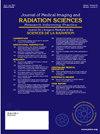A preliminary study of deep learning-based compressed sensing accelerated mDIXON for segmented coronary adipose tissue evaluation in patients with suspected coronary artery disease
IF 1.3
Q3 RADIOLOGY, NUCLEAR MEDICINE & MEDICAL IMAGING
Journal of Medical Imaging and Radiation Sciences
Pub Date : 2024-10-01
DOI:10.1016/j.jmir.2024.101503
引用次数: 0
Abstract
Background
The secretion of dysfunctional PCAT is positively correlated with coronary artery stenosis, degree of calcification, and plaque progression. It is important to develop novel clinical diagnostic tools for coronary heart disease based on PCAT assessment. Homsi et al. introduced and validated coronary magnetic resonance angiography (MRA), based on the three-dimensional (3D)-modified Dixon (mDIXON) technique, for epicardial adipose tissue quantification. Therefore, the present study was to use non-contrast-enhanced compressed sensing artificial intelligence framework 3D mDIXON coronary MRA for PCAT quantification in patients with suspected CAD. It also evaluated segmented PCAT's relationship with coronary plaque characteristics and stenosis severity.
Methods
The study protocol was approved by the institutional ethics committee of the hospital. We included 35 symptomatic patients with CAD (111 arteries with plaque, 169 without plaque) (Figure 1). All the subjects underwent CMR on a 3T clinical MR scanner to evaluate segmented PCAT volume and fat-fraction of 8 coronary segments. We manually traced the segmented PCAT volume, and calculated the fat fraction of the segmented PCAT by formula: only fat images (F)/F + only water images (W). We compared the segmented PCAT volume and fat-fraction across 8 coronary segments with different plaque types and degrees of stenosis defined with CCTA and explored the relationship between them.
Results
The coronary segments with plaques had a higher segmented PCAT volume and fat-fraction than those without plaques. Meanwhile, segmented PCAT volume around mixed plaques was larger than non-calcified or calcified plaques (p = 0.014 and p < 0.001) (Figure 3). There was a moderate correlation between the segmented PCAT volume and plaque type (r = 0.493, p < 0.001). The fat-fraction had similar results (r = 0.480, p < 0.001).
Conclusion
The non-contrast-enhanced, whole-heart coronary MRA framework with CSAI is able to measure segmented PCAT volume and fat-fraction. The segmented PCAT volume is more significantly associated with the coronary plaque characters than fat-fraction.
基于深度学习的压缩传感加速 mDIXON 用于疑似冠状动脉疾病患者冠状动脉脂肪组织分段评估的初步研究
背景功能障碍 PCAT 的分泌与冠状动脉狭窄、钙化程度和斑块进展呈正相关。开发基于 PCAT 评估的新型冠心病临床诊断工具非常重要。Homsi 等人介绍并验证了基于三维(3D)改良狄克逊(mDIXON)技术的冠状动脉磁共振血管造影术(MRA),用于心外膜脂肪组织的量化。因此,本研究使用非对比度增强压缩传感人工智能框架三维 mDIXON 冠状动脉 MRA 对疑似 CAD 患者的 PCAT 进行量化。该研究还评估了分段 PCAT 与冠状动脉斑块特征和狭窄严重程度的关系。我们纳入了 35 名有症状的 CAD 患者(111 条动脉有斑块,169 条动脉无斑块)(图 1)。所有受试者都在 3T 临床磁共振扫描仪上接受了 CMR 扫描,以评估 8 个冠状动脉节段的 PCAT 容量和脂肪率。我们手动描记分段 PCAT 体积,并通过公式计算分段 PCAT 的脂肪率:仅脂肪图像(F)/F + 仅水图像(W)。我们比较了 CCTA 定义的 8 个不同斑块类型和狭窄程度的冠状动脉节段的分段 PCAT 容量和脂肪比例,并探讨了它们之间的关系。结果有斑块的冠状动脉节段的分段 PCAT 容量和脂肪比例均高于无斑块的节段。同时,混合斑块周围的分段 PCAT 容量大于非钙化或钙化斑块(p = 0.014 和 p <0.001)(图 3)。分段 PCAT 容量与斑块类型之间存在中度相关性(r = 0.493,p < 0.001)。结论使用 CSAI 的非对比度增强全心冠状动脉 MRA 框架能够测量分段 PCAT 容量和脂肪比例。分段 PCAT 容量与冠状动脉斑块特征的相关性比脂肪比例更显著。
本文章由计算机程序翻译,如有差异,请以英文原文为准。
求助全文
约1分钟内获得全文
求助全文
来源期刊

Journal of Medical Imaging and Radiation Sciences
RADIOLOGY, NUCLEAR MEDICINE & MEDICAL IMAGING-
CiteScore
2.30
自引率
11.10%
发文量
231
审稿时长
53 days
期刊介绍:
Journal of Medical Imaging and Radiation Sciences is the official peer-reviewed journal of the Canadian Association of Medical Radiation Technologists. This journal is published four times a year and is circulated to approximately 11,000 medical radiation technologists, libraries and radiology departments throughout Canada, the United States and overseas. The Journal publishes articles on recent research, new technology and techniques, professional practices, technologists viewpoints as well as relevant book reviews.
 求助内容:
求助内容: 应助结果提醒方式:
应助结果提醒方式:


